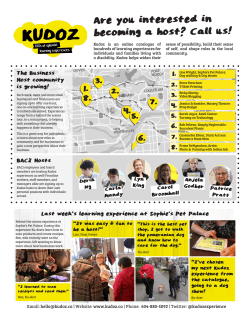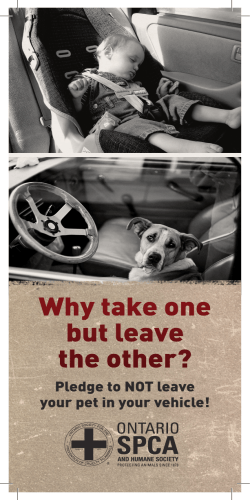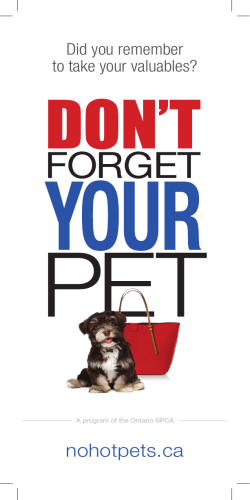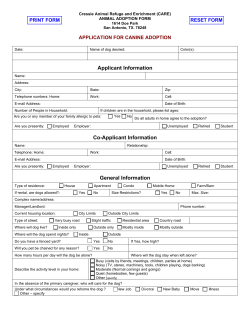
Junior Level - Humane Society of Broward County
Humane Society of Broward County & Girl Scouts of Southeast Florida
HUMANE SOCIETY OF BROWARD COUNTY
“NO BONES ABOUT IT” PET CARE PATCH PROGRAM
Leader’s Guide
Junior Level Requirements
Girl Scouts of Southeast Florida
4701 NW 33 Avenue
Oakland Park, FL 33309
(954) 739-7660
Humane Society of Broward County
2070 Griffin Road
Fort Lauderdale, FL 33312
(954) 989-3977
HUMANE SOCIETY OF BROWARD COUNTY
‘No Bones About It’ Pet Care Patch Program Description
The ‘No Bones About It’ Pet Care Patch Program consists of four levels: Daisy, Brownie, Junior, and
Cadette/Senior. At each level, the girls do a variety of age-appropriate activities to teach them about
being responsible pet people. All activities are done during troop meetings or at home. The last
activity the troop will do is visit the Humane Society for a tour. To schedule a tour, the troop leader
should call 954-266-6848. Tours are offered Monday through Friday. Please call at least one month
in advance. Patches will be issued only after all activities and the tour are completed. The cost of the
patches per girl is $4. Cash or checks (made payable to the Humane Society of Broward County) are
accepted.
In order for the girls to earn the No Bones About It Patch, the following must occur:
The girls must complete all required activities before coming for the tour.
The girls must come to the tour prepared to talk and answer questions about the
activities they did.
The troop leader should completely fill out the Patch Program Evaluation Form (the
second to the last page of this guide) and turn it in at the beginning of the tour.
LEADERS: Please review the following with your troop before introducing the activities:
What is the Humane Society of Broward County?
The Humane Society is an animal shelter that cares for dogs, cats and rabbits that don’t have homes. Most of
the animals are brought to the Humane Society by their owners. Who can think of a reason why someone might
have to give up their pet? Sadly, hundreds of pets are left at the Humane Society of Broward County by their
owners each week. The Humane Society takes good care of all the dogs, cats and rabbits in their care and
works very hard to find them new families to adopt them and give them a loving, life-long home.
2
HUMANE SOCIETY OF BROWARD COUNTY
‘No Bones About It’ Pet Care Patch
Junior Girl Scout Level
Junior Girl Scouts must complete 6 of the 9 activities listed below, as well as visit the
Humane Society for a tour. Tours are offered Monday through Friday. Please call 954266-6848 to schedule a tour (please call at least one month in advance).
1. How do dogs and cats communicate or talk to us? They mostly use body language. That means
you can tell how they are feeling by looking at the way their body is positioned. How do dogs and cats
tell us when they are happy, sad, scared, angry, or sick? Complete the “Dog Talk” sheet on page 5
and see if you can guess what each dog is trying to say. What is it about the dog’s body language
that makes you think that? Observe your dog or cat and explain their body language. Check your
answers with the key on page 17.
2. Most of the pets at the Humane Society lost their home because their family could no longer care
for them. How do you think a dog or a cat feels when they lose their family and everything they have
ever known? Talk about it with your troop. Try to put yourself in the animal’s place. Go on the
Humane Society’s website (www.humanebroward.com) and look at the photos of the adoptable pets.
Choose one. As a troop, write a letter from that animal’s point of view (have the troop leader write it, if
necessary) to someone who might want to give the pet a good home. Tell the person why they
should adopt this particular animal. Bring your letter with you when you come for the tour.
34. Discover the importance of identification for your pet. Learn about the different types of
identification: I.D. tags, tattoos and the microchip. Discuss the pros and cons of each type of
identification. Find out which of the three is the most beneficial in reuniting a lost pet with his family.
Using the blank tag on page 6, design a tag that includes all the information a person who finds a lost
pet would need to contact the pet’s family. Check to see if each of your pets has identification. If they
don’t, get one made at your local pet supply store or at HSBC today! What would you do if your pets
got lost? Read the tips on page 7 and talk about them with your troop.
4. How much does it really cost to get a dog? The cost of a pet is only the beginning of the money
you will spend caring for the pet. On page 8, determine how much it actually costs to get a dog. To
find the prices, visit a local pet supply store, call a veterinarian, or search online.
5. Learn about safe toys for your pets on page 9. Create a safe toy for your own pet or make one for
a shelter pet! (Bring it to the shelter when you come for your tour.)
3
6. Have each troop member create a first aid kit for their pet. Check out the ideas on page 11.
Compare the contents between a human first aid kit and a pet first aid kit.
7. Find out about how to keep your pet safe from heartworm disease on pages 12 and 13.
8. Is your pet a “good citizen”? See page 14 to learn about laws that pertain to pets. Why are these
laws important? What if there were no such laws? Talk about them with your troop. Color the coloring
sheet on page15.
9. What is the difference between a domesticated animal and a wild animal? Are dogs and cats
domesticated or wild? Read the information on page 16, and then design a poster to be hung at the
Humane Society to educate people about why they should never abandon a pet.
4
5
Design an I.D. tag for a pet
Fill in the above I.D. tag with all the information a person who finds
a lost pet would need to contact the pet’s family. Compare your tag
with those of your troop members.
6
My pet is lost! What should I do?
Go look for your pet right away!
Look all over your neighborhood, in bushes, up in trees and on top of
roofs (if your pet is a cat or a bird). Call your pet’s name and shake his
treat bag or squeak his toy. Ask your neighbors if they have seen or
heard an unfamiliar pet. Often, pets will come out at night when they
feel safer.
Make a flyer that includes: a clear photo of your pet, the date he was
lost, the nearest major intersection near where he was last seen, the
color of his collar, his breed, age, and whether he is a boy or a girl. Also
include information about a reward if you are offering one, and your
phone number! Put the flyers all over your neighborhood, at local
stores, schools, churches, and pet supply stores.
Go to the Humane Society of Broward County and to Broward County
Animal Care and Adoptions to fill out a lost pet report. Be sure to bring
photos of your pet! Look at all of the animals they have to see if your
pet is one of them. Go look each day if possible.
Post an ad on online lost pet registries/bulletin boards.
Put an ad in the newspaper. Offer a REWARD!
Don’t give up! Pets can turn up at shelters weeks or months after they
are lost.
7
How Much Does It Really Cost To Get A Dog?
The cost of a pet is only the beginning of the money you will spend caring for the pet. Determine how
much it actually costs to get a dog. To find the prices, visit a local pet supply store, call a veterinarian,
or search online. Hint: The Humane Society of Broward County also offers many of these services!
Learn more at www.humanebroward.com.
Cost of the dog
Leash
Collar
I.D. tag
County license
Microchip I.D.
Training classes
Food and water bowls
Flea control
Brush
Heartworm disease preventative
Toys
Food
Deworming
Spay/neuter surgery
Vaccinations
Grooming
Check-up at the vet
Boarding
Bed
Crate for training
Total:
$________
$________
$________
$________
$________
$________
$________
$________
$________
$________
$________
$________
$________
$________
$________
$________
$________
$________
$________
$________
$________
$________
Pets can be expensive! It is important to carefully consider the true costs
of getting a pet BEFORE you get one!
Did you know…when you adopt a dog or a cat from the Humane Society of Broward
County, the low adoption fee includes the pet’s up-to-date vaccinations, license,
microchip I.D., and spay/neuter surgery! What a great deal!
8
Safe Games And Toys For Your Pets!
It’s important to take time to play with your pets each day - they get bored just like you do and
tend to gain weight and become depressed if they don’t get enough activity. Pets can also
become rambunctious and destructive if they don’t get enough exercise. Put aside a half-hour
each day to play with and exercise your pet. Choose one of the suggested games or create
your own safe toy for your pet to play with.
Safety First!
♥ Never let your cat play with ribbon, yarn, string or tinsel! If they swallow it, it could cause
major damage to their intestines. (For the same reason, make sure dog don’t eat dental floss
from bathroom garbage cans!)
♥ Don’t let your dog play with small cat toys, small balls, or other small items that he could
swallow and choke on.
♥ Many cats love to play with laser lights but be careful not to shine it in their eyes.
♥ Don’t give your pet bones left over from dinner. He could chew them up and eat them and
they could puncture his stomach.
♥ Don’t let your cat play in plastic bags!
Toy and Game Ideas to Try
Knot a tennis ball in an old sock and throw it for your dog!
Fill a small sock with catnip and cotton. Stitch the end up, and watch your kitty go crazy!
Stuff a Kong toy with peanut butter and it will keep your dog busy for hours.
Decorate a paper shopping bag (remove the handles if it has them) and cut a few holes in it –
your cat will love to hide in it.
Blow bubbles for your dog or cat to chase.
Play hide-and-seek with your dog! Have your dog sit and stay, then you go hide some where
in the house (make it an easy place first). Have a treat in your hand. Then, call your dog to
come to you. When he finds you, praise him and give him the treat.
Some dogs and cats may enjoy having their own stuffed toy or animal to snuggle with, carry
around, or wrestle with.
Check out the following page for ideas of toys for pets other than dogs or cats!
9
10
Make A First Aid Kit For Your Pet!
If your pet gets hurt, he will depend on you to get him the help he needs. This will
probably mean taking him to a veterinarian. Sometimes pets only have very minor
injuries (such as a minor scratch or a tick bite) which is where having a pet first aid kit
would come in handy. Below is a list of things that make up a good pet first aid kit. The
time to put your first aid kit together is TODAY, before your pet gets hurt!
Medical Tape Roll
4 Gauze Pads (4" x 4")
4 Gauze Pad (2" x2")
2 Gauze Roll (2" wide)
Examination Gloves
Instant Cold Pack
Tweezers
Antibiotic Ointment
Alcohol Pads
Antiseptic Towelettes
Pet First Aid Guide – VERY IMPORTANT!
Leg Splints/Tongue Depressors
Cotton swabs
Elastic Bandage 2" ("Ace Bandage")
Sting Relief Pads
Eye wash
Hydrogen peroxide (to induce vomiting)
Rectal Thermometer
Also include important phone numbers:
Your veterinarian: ____________________________
24-hour emergency animal hospital: ____________________________
ASPCA Poison Control Hotline: _____888-426-4435____________
Note: Never try to handle an injured pet yourself. Animals that are in pain may bite out
of fear, even if they know you. It is best to let an adult or medical professional tend to
the hurt animal. If the animal’s injuries are more than minor, have an adult take the
animal to a veterinarian immediately!!!
11
Beware of the Heartworm!
What is heartworm disease?
Heartworm disease is a condition in which worms enter a pet’s circulatory system via a mosquito bite
and invade the animal’s heart. Each year, thousands of dogs become infected with heartworm
disease and many of them die from it. The treatment of the disease if very hard on the dog.
Essentially, a veterinarian must poison the worms to kill them, but the dog is poisoned at the same
time. The treatment is time-consuming and expensive. Luckily, it is a preventable disease.
In Florida, pets are in danger of getting heartworm disease year-round.
A veterinarian can do a quick and simple blood test to determine if a pet is developing the disease.
As long as the test is clear, the pet should start on a heartworm preventative.
12
“Beware of the Heartworm” Skit
Choose a person to play each of the following parts: Pet Parent, Veterinarian, Vet Assistant,
Mosquito, Dog, and Family.
Part 1 - “The Healthy Dog”
Pet Parent: I just adopted a dog and want to be sure he is healthy. I’m going to take him to the vet!
Veterinarian: I’m the vet! One thing we’re going to check Fido for is a disease called heartworm
disease. It is a disease that is transmitted through mosquitoes. Mosquitoes are very common in
Florida, so you must protect your dog. Otherwise he could get very sick! Let’s take him over to the vet
assistant who will check him out.
Vet Assistant: I’m the vet assistant. The way we check for heartworm disease is by taking a sample
of blood from Fido and running a simple test. We will have the results in only a few minutes… The
results are negative! Fido does not have heartworm disease. We had better get him on a
preventative right away.
Part 2 - “The Unhealthy Dog”
Mosquito: I am a mosquito and I’m hungry for a nice fuzzy dog! Here poochie, poochie…Oh look! I’ve
found a yummy dog – I think I’ll chomp on him! Wow, this dog has some extra treats in his blood, little
baby worms called microfilariea. After two or three weeks…the baby worms have developed inside
me into infective larvae. Cool! I’m hungry again…time to find another dog for dinner. While I’m
feeding on his blood, I’ll dump some of these infected worms into his skin, that’ll take a load off. Good
bye, doggie…
Dog: Good bye, doggie? You have made me sick! These larvae are migrating through my tissues and
into my heart. I’m not feeling well at all…I’m feeling tired and I’m starting to cough all the time and I
don’t feel much like eating. A few months have gone by and the worms inside my heart are up to 14
inches long!. I wish my family would have taken me to the vet so this wouldn’t have happened. Here
comes my family now…
Family: We’re Fido’s family and we haven’t been very responsible. It may be too late-our dog is very
sick. We better take him to the vet!
Veterinarian: I’m the vet and I suspect your dog has heartworm disease. I’ll take a blood sample to
test for the disease. In a few minutes my assistant will have the results. (A few minutes later…) The
results are positive-your dog has heartworm disease. Since you waited so long your dog has severe
damage to his heart and lungs. They cannot be repaired. We wish you would have come in earlier
because if it had been caught earlier, we may have been able to treat the dog. The treatment is risky,
though. This is why I urge pet lovers to have their pets on heartworm prevention. You could be saving
your pet’s life!
13
Is Your Pet A “Good Citizen”?
Most communities have laws concerning pets. These laws are meant to maintain the
health and safety of the people and animals in the community. As a troop, take turns
reading the important information below and discuss the answers to the questions. The
laws listed below are similar to those commonly found in communities throughout the
U.S. They all apply in Broward County, Florida.
Leash law
Dogs are not allowed to run loose off their owner’s property. They must be kept
indoors or in a fenced yard. If they are off of their owner’s property, they must be
on a leash or in a carrier.
Imagine if people were allowed to let their dogs run loose. Would it present a
danger to people? In what way(s)? Would it present a danger to other animals?
There is no leash law for cats. Do you think there should be? Why or why not?
“Pooper Scooper” law
People must immediately clean up their pet’s waste if their pet defecates (goes to the bathroom) on
someone else’s property.
Why is it important for people to clean up after their pets? What if no one ever did?
Rabies Vaccination Requirement
All dogs and cats that are four months and older must be vaccinated against
rabies. Rabies is a serious disease that is contagious between animals and
humans. It is extremely rare for a person to catch rabies from a dog or a cat,
though, largely because rabies vaccines are required for dogs and cats throughout
the U.S. and this has kept the disease under control.
How has dogs and cats being vaccinated for rabies helped humans?
“License Law”
All dogs and cats that are four months and older must wear a license on their collar. The license is
issued through the county where the pet lives. A license is also called a ‘tag’. The license is used to
help identify a pet if he becomes lost or stolen. It is also used to keep track of which pets have
received the required rabies vaccine. Also, counties use licensing to keep statistics on owned pets.
Owners often must renew their licenses yearly.
“Nuisance law”
Pet owners must not allow their pets to bother or be a nuisance to other people.
For example, it would be considered a nuisance for a person to allow their dog to
bark all night, every night, in the yard. And, it would be a nuisance for a person to
allow their cat to dig up plants in a neighbor’s garden each day.
Do dogs and cats always know how we want them to behave? Whose
responsibility is it to make sure that pets do not bother others?
14
15
Why Our Pets Depend On Us
Dogs and cats depend on humans in order to survive. Thousands of years ago, dogs and cats
were wild animals. They had the instincts to hunt, find shelter and to fend for themselves
against the dangers that they faced in the wild. But then humans realized how wonderful these
creatures were and decided that they wanted to keep them around and take care of them.
They gave the dogs and cats food, water, and shelter, and protected them from harm. After
thousands of years of being cared by humans, dogs and cats forgot how to do these things for
themselves! They are no longer wild animals. They are now what we call domesticated
animals. That means that they depend on us to provide them with food, water, shelter,
medical care, and grooming, and they need us to protect them from harm.
vs.
Domesticated
Wild
Dogs and cats that are forced to live on the streets live very short, sad lives. Since they have
no one to feed them, they have no choice but to eat rotten food from garbage cans, which can
make them very sick. Since they have no one to give them clean water, they are forced to
drink dirty water from puddles on the street. Many of these animals die from starvation. While
on the streets without humans to care for them, many dogs and cats get hit by cars or are
attacked by other animals. Many of them will suffer from injuries and disease. Sometimes,
cruel people will intentionally hurt animals they see roaming the streets. For this reason, it is
very important that people do not abandon their pets on the street or anywhere else.
Abandoning a dog or cat is such a bad idea that it is in fact against the law. Instead, people
should call the Humane Society to assist them with finding their pet a new home.
As a troop, design a poster to educate people about the
dangers of abandoning pets. Bring it to the Humane Society
when you visit for your tour and we will hang in on our wall!
16
Dog Talk Answer Key (Activity #1)
1. I’m angry, so back away. My hair is standing up, my tail is up and my teeth are
showing. I might be growling. Leave me alone!
2. I’m scared! My eyes are half-closed, my ears are back and my tail is between my
legs. I might even crouch down on the floor and roll onto my back. I’m afraid, so
please give me my space.
3. I’m a happy dog! My ears are up and my body is relaxed. My tail is up. I’m
approachable!
4. Let’s play! My rear end is up in the air and my tail is up and wagging. My paws are
on the ground as if I’m bowing to you. My ears are forward and my face looks
happy. Come on! Let’s play!
5. I’m lonely! I’m all by myself and I want some company so I’m howling like a wolf to
try and attract my family to come to me. If I am your dog, please spend more time
with me!
6. Dog #1 – I am an angry dog! My hair is standing up, my tail is up and my teeth are
showing. I might be growling. I am showing Dog #2 that I am the boss!
Dog #2 - I am REALLY scared! My ears are pinned back, my eyes are closed and
my tail is between my legs. I am crouching down to show Dog #1 the HE
IS the boss of me!
17
Humane Society
of Broward County
Humane Society
of Broward County
Wish List
Wish List
The Humane Society of Broward County is a nonprofit organization that relies on donations to care for
the thousands of animals we receive each year.
The Humane Society of Broward County is a nonprofit organization that relies on donations to care for
the thousands of animals we receive each year.
Monetary Donations.
Monetary Donations.
Bath Towels & Wash Cloths.
Bath Towels & Wash Cloths.
Dog & Cat Treats.
Dog & Cat Treats.
Toys - BIG rubber chew toys for dogs,
ping pong balls for cats, and plastic cat
toys with bells inside for bunnies.
Toys - BIG rubber chew toys for dogs,
ping pong balls for cats, and plastic cat
toys with bells inside for bunnies.
Office Supplies – copy paper, staples,
scissors, craft supplies, etc.
Office Supplies – copy paper, staples,
scissors, craft supplies, etc.
Cleaning Supplies - paper towels,
dishwasher soap, laundry detergent,
powdered bleach, disinfecting wipes.
Cleaning Supplies - paper towels,
dishwasher soap, laundry detergent,
powdered bleach, disinfecting wipes.
Clinic Supplies - rubbing alcohol,
KMR - kitten milk replacer, Esbilac puppy milk replacer, canned puppy &
kitten food, hand sanitizer.
Clinic Supplies - rubbing alcohol,
KMR - kitten milk replacer, Esbilac puppy milk replacer, canned puppy &
kitten food, hand sanitizer.
Nestle Purina generously donates food
for the pets in our care, therefore,
we have all the dry food we need.
Nestle Purina generously donates food
for the pets in our care, therefore,
we have all the dry food we need.
Thank you for your support!
Thank you for your support!
Humane Society of Broward County
2070 Griffin Road, Fort Lauderdale, FL 33312
954.989.3977 humanebroward.com
Humane Society of Broward County
2070 Griffin Road, Fort Lauderdale, FL 33312
954.989.3977 humanebroward.com
18
HUMANE SOCIETY OF BROWARD COUNTY
‘No Bones About It’ Pet Care Patch Program Evaluation Form
Junior Level
Troop Number: ____________________ Troop Leader’s Name: __________________________
Girl Scout’s Name (if done as an individual): ____________________________
1. Which 6 activities did you / your troop complete?
1.
4.
2.
5.
3.
6.
2. What was your favorite activity and why? _________________________________________
__________________________________________________________________________
3. Name at least one thing you learned from the Patch Program that you didn’t know before:
__________________________________________________________________________
__________________________________________________________________________
This form must be completed and turned in at the beginning of the tour in order
for the troop to receive their patches. Thanks!
19
Order Your ‘NO BONES ABOUT IT’ Patches Today!
(for out-of-town troops)
Troop Level and Number: ________________________________________________
Troop Leader’s Name: ________________________ Phone: ____________________
Number of Girls in Troop: ________________________________________________
(Include $4.00 per girl)
Please add $3 to the total for shipping!
Mail patches to:
Name:_______________________________________________________________
Address:______________________________ City, State & Zip:__________________
Please make your check payable to:
Humane Society of Broward County
c/o Education Department
2070 Griffin Road
Fort Lauderdale, FL 33312
Your evaluation form must be included with your order
20
© Copyright 2025









